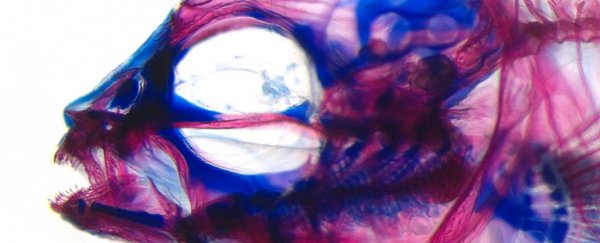Of the many variations between organisms in a species, only some of them can currently be explained by differences in their genetic code, but a new study has shed light on one of the other ways variations can occur.
Researchers looking at the cichlid fish, an African species, found that how they exercise their jaws as larvae can influence how the skull develops, with more vigorous "gaping" leading to stronger bone development.
The team from the University of Massachusetts Amherst suggests this is important new evidence in our investigation of varying traits in species that aren't passed down through their built-in genetic code.
In this case the scientists looked at the mouth movements or "vigorous gaping" observed by larval fish, starting straight away after the lower jaw cartilage forms but before bones start solidifying.
"We predicted that the baby fish are exercising their jaw muscles, which should impose forces on the bones they attach to, forces that might stimulate bone formation," says one of the researchers, evolutionary biologist Craig Albertson.
In some fish the gaping frequency was up to 200 times per minute, and Albertson says the team noticed variations in a way that "foreshadows differences in bone deposition around processes critical for the action of jaw opening".
In other words it's not just the DNA code these fish are born with but also the gaping behaviour in their earliest days that aids bone development.
"Variation in skull shape is highly heritable, so why can we only find genetic variability that accounts for such a small amount of variability in bone development?" asks Albertson. "In my lab we have shifted from elaborating our genetic models to looking more closely at the interaction between genetics and the environment."
Based on experiments the researchers carried out, slowing or speeding up the gaping rate influenced bone development by as much as 15 percent.
That compares with up to 20 percent variability in bone development from genetic manipulations the team has carried out over the last 15 years – so the figures from genetic and non-genetic manipulation are fairly close.
"When I give talks, this is what surprises colleagues the most, that the environmental effect is on par with the genetic effect, and that it is not systemic but highly specific to important bones involved in fish feeding," says Albertson.
The researchers suggest the fish are using gaping to fine-tune individual responses to their genetic code, kickstarting the process of adapting phenotypes that can then respond to the environment and ultimately maximise the chances of the survival of the species.
Indeed the next work the team wants to do is looking at how stimuli in the environment can prompt the development of traits like skull shape. The hypothesis is that species have certain molecules and gene expressions that react to environmental changes to help meet whatever new challenges come along.
"This is just the beginning," says Albertson. "Our field has been entrenched in a gene-centred view of evolution for nearly a century. My hope is that this study adds to a growing body of literature that shows there are other important sources of variation."
The work has been published in Proceedings of the Royal Society B.
